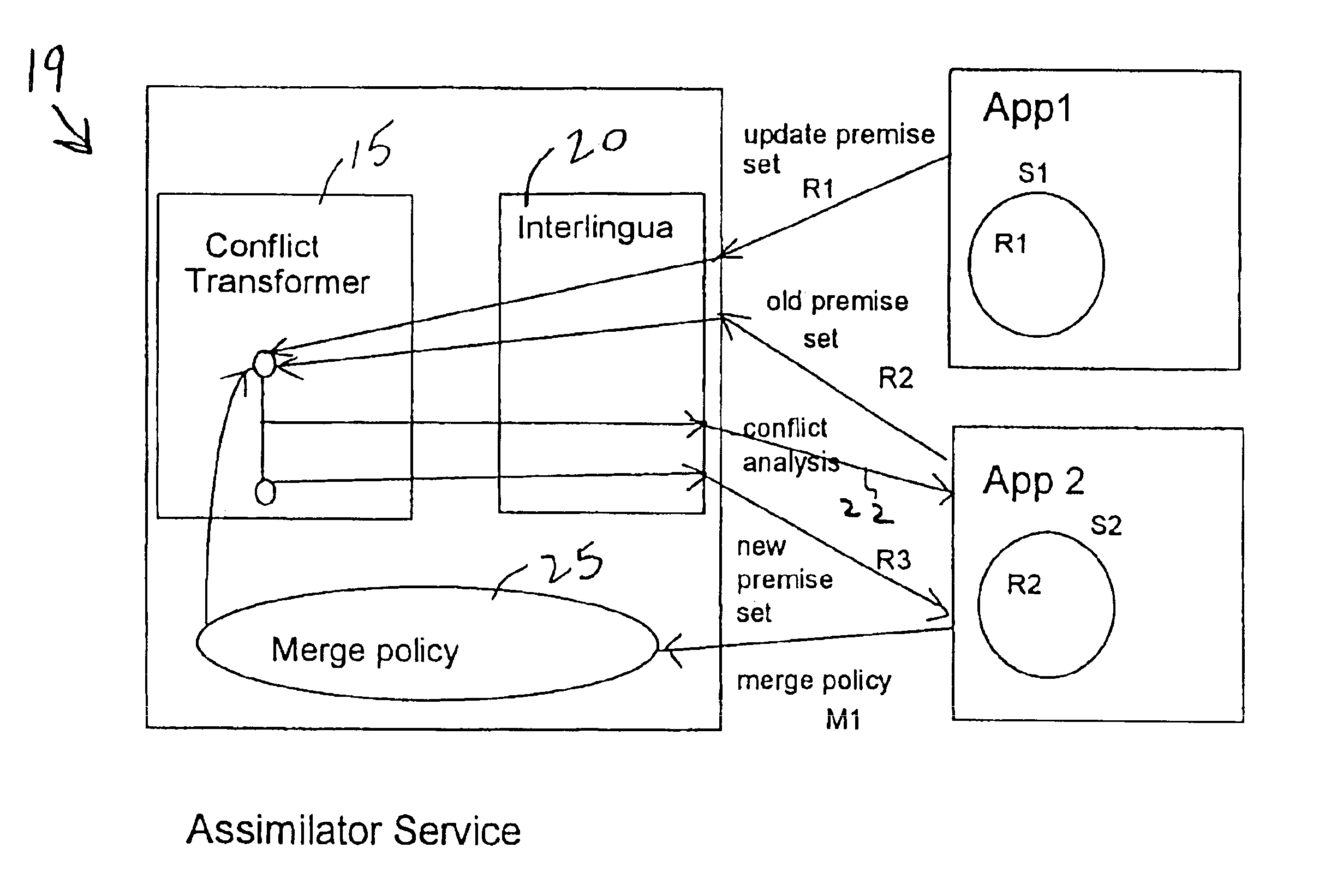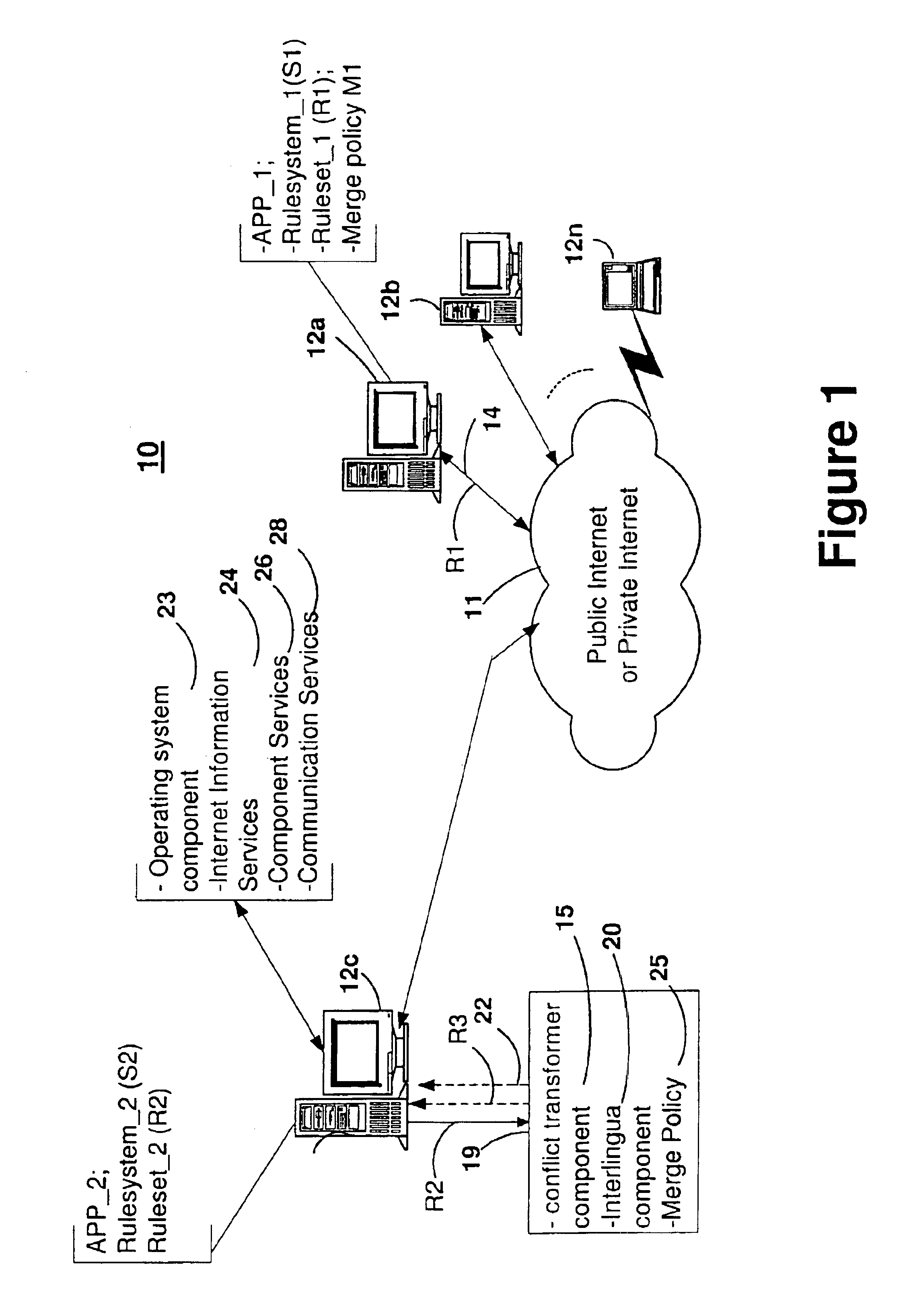Conflict-handling assimilator service for exchange of rules with merging
a technology of assimilator service and conflict handling, applied in the field of rules-based systems for representing knowledge, can solve problems such as inability to implement blind search oriented approach implemented in the rules-based system shell, and inability to solve conflicts. the historical difficulty of lack of a systematic way to resolve conflicts, etc., to achieve the effect of high reuse and easy integration
- Summary
- Abstract
- Description
- Claims
- Application Information
AI Technical Summary
Benefits of technology
Problems solved by technology
Method used
Image
Examples
example 1
[0046]Assuming a patient cannot take aspirin and thyomine together. If the patient is female who is pregnant, then the resulting rulesets and the merge policy (Mutex) that excludes the prescription of both aspirin and thyomine (drug names are hypothetical) is provided in the pseudocode version as follows:[0047] / * RuleSet 1, treatment of minor pain * / [0048]1>prescription(aspirin, ?Patient)[0049] / * RuleSet 2, treatment of ulcer * / [0050]2_1>prescription(thyomine, ?Patient)[0051] / * Merge policy * / [0052]MUTEX_HEAD[0053]prescription(thyomine, ?Patient) MUTEX_GIVEN[0054]pregnant(?Patient).
[0055]A Prioritization predicate or “overrides” used to specify prioritization may be represented generally as follows:[0056]Overrides (ij) which specify that the rule with label “i” has (strictly) higher priority than the rule with label “j.”
[0057]Conditional overrides used to specify prioritization may be represented generally as follows:[0058]overrides (ij)1(ij) AND L2(ij) which specifies that rule “i”...
example 2
[0061]Given first and second rulesets as follows:[0062] / * ruleset 1 * / [0063]cneg important(?Msg)[0064] / * ruleset 2 * / [0065]important(?Msg)[0066]important(?Msg)
[0067]It is apparent that the rule in ruleset 1 is in conflict with and rules in ruleset 2. E.g., rule indicates msg is NOT important by the cneg operator which contradicts with and rules in ruleset 2. Thus, to remedy this conflict, the following prioritization fact may be added to the merge policy in the form of an exception override to the junk rule as follows:[0068] / * merge policy * / [0069]overrides(del, jun).[0070]overrides(fav, jun).
[0071]It should be understood that, in addition to mutex's and override statements, the merge policy further includes logic, i.e., to decide when to apply overrides and the mutexes. Further, when a merge policy is applied to a set of facts or a premise set, they may be refuted or rendered skeptical.
example 3
[0072]The following example illustrates an example merging of two rulesets given in accordance with a supplied merge policy after identifying the potential conflicts in the rules. This example relates to an example store return policy wherein there is implemented a rule A) enabling a product return for full credit less 10% deposit, for any reason, within 30 days; and a rule b) enabling a return for full credit, if purchase is defective, within 1 year.
[0073]Rule A) may be represented as follows:[0074] refund(?Return,percent90)<−return(?Return) and delay(?Return,?D) and lessThanOrEqual(?D,days30),
while Rule B) may be represented as follows:[0075] refund(?Return,percent100)
[0076]Obviously there is a potential scenario where both of these rules apply. So a merge policy is provided so that defective guarantees have a higher priority than unconditional guarantees. This is stated as follows:[0077]overrides(defectiveGuarantee,unconditionalGuarantee).Additionally, there is provided a MUTEX H...
PUM
 Login to View More
Login to View More Abstract
Description
Claims
Application Information
 Login to View More
Login to View More - R&D
- Intellectual Property
- Life Sciences
- Materials
- Tech Scout
- Unparalleled Data Quality
- Higher Quality Content
- 60% Fewer Hallucinations
Browse by: Latest US Patents, China's latest patents, Technical Efficacy Thesaurus, Application Domain, Technology Topic, Popular Technical Reports.
© 2025 PatSnap. All rights reserved.Legal|Privacy policy|Modern Slavery Act Transparency Statement|Sitemap|About US| Contact US: help@patsnap.com



